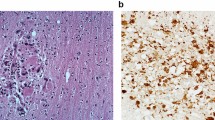Summary
A 25-year-old homosexual AIDS patient presented with progressive cognitive, motor and behavioral disturbances consistent with HIV encephalopathy. CT scans demonstrated progressive diffuse brain atrophy. Neuropathology showed predominant cortical changes including severe neuronal loss corroborated by morphometry. Only minimal changes were found in the white matter and basal ganglia. Immunocytochemistry for HIV stained occasional microglial cells more markedly in the cerebral cortex. This suggests that HIV infection of the brain may cause predominant cortical nerve cell loss, and that HIV encephalopathy is not necessarily due to white matter lesions.
Similar content being viewed by others
References
Budka H (1989) Human immunodeficiency virus (HIV)-induced disease of the central nervous system: pathology and implications for pathogenesis. Acta Neuropathol 77:225–236
Budka H, Costanzi G, Cristina S, Lechi A, Parravicini C, Trabattoni R, Vago L (1987) Brain pathology induced by infections with the human immunodeficiency virus (HIV). A histological, immunocytochemical, and electron microscopical study of 100 autopsy cases. Acta Neuropathol (Berl) 75:184–198
Centers for Disease Control, US Department of Health and Human Services; Atlanta, Georgia (1986) Classification system for human T-lymphotropic virus type III/lymphadenopahty-associated virus infections. Ann Intern Med 105:234–237
Centers for disease control (1987) Revision of the CDC surveillance case definition for acquired immunodeficiency syndrome. J Am Med Assoc 258:1143–1154
Ciardi A, Sinclair E, Scaravilli F, Harcourt-Webster NJ, Lucas S (1990) The involvement of the cerebral cortex in human immunodeficiency virus encephalopathy: a morphological and immunohistochemical study. Acta Neuropathol 81:51–59
Clague CPT, Ostrowski MA, Deck JHN, Harnish DG, Colley EA, Stead RH (1988) Severe diffuse necrotizing cortical encephalopathy in acquired immune deficiency syndrome (AIDS): an immunocytochemical and ultrastructural study (abstract). J Neuropathol Exp Neurol 47:346
Dal Canto MC (1989) AIDS and the nervous system: current status and future perspectives. Hum Pathol 20:410–418
De Girolami U, Smith TW, Hénin D, Hauw JJ (1990) Neuropathology of the acquired immunodeficiency syndrome. Arch Pathol Lab Med 114:643–655
Floderus S (1944) Untersuchungen über den Bau der menschlichen Hypophyse mit besonderer Berücksichtigung der quantitativen mikromorphologischen Verhältnisse. Acta Pathol Microbiol Scand 53 [Suppl]:80–98
Gabudza DH, Hirsch MS (1987) Neurologic manifestations of infection with human immunodeficiency virus. Clinical features and pathogenesis. Ann Intern Med 107:383–391
Giangaspero F, Scanabissi E, Baldacci MC, Betts CM (1989) Massive neuronal destruction in human immunodeficiency virus (HIV) encephalitis. A clinico-pathological study of a pediatric case. Acta Neuropathol 78:662–665
Gray F, Gherardi R, Keohane C, Favolini M, Sobel A, Poirier J (1988) Pathology of the central nervous system in 40 cases of acquired immune deficiency syndrome (AIDS). Neuropathol Appl Neurobiol 14:365–380
Haug H (1967) Probleme und Methoden der Strukturzählung im Schnittpräparat. In: Weibel ER, Elias H (eds) Quantitative methods in morphology. Springer, Berlin, pp 58–78
Haug H, Kühl S, Mecke E, Sass NL, Wasner K (1984) The significance of morphometric procedures in the investigation of age changes in cytoarchitectonic structures of human brain. J Hirnforsch 25:353–374
Ketzler S, Weis S, Haug H, Budka H (1990) Loss of neurons in the frontal cortex in AIDS brains. Acta Neuropathol 80:92–94
Monte SM de la, Ho DD, Schooley RT, Hirsch MS, Richardson EP Jr (1987) Subactue encephalomyelitis of AIDS and its relation to HTLV-III infection. Neurology 37:562–569
Navia BA, Jordan BD, Price RW (1986) The AIDS dementia complex. I. Clinical features. Ann Neurol 19:517–524
Navia BA, Cho E-S, Petito CK, Price RW (1986) The AIDS dementia complex. II. Neuropathology. Ann Neurol 19:525–535
Petito CK, Navia BA, Cho E-S, Jordan DC, Price DW (1985) Vacuolar myelopathy pathologically resembling subacute combined degeneration in patients with the acquired immunodeficiency syndrome (AIDS). N Engl J Med 312:874–879
Petito CK, Cho E-S, Lemann W, Navia BA, Price RW (1986) Neuropathology of acquired immunodeficiency syndrome (AIDS): an autopsy review. J Neuropathol Exp Neurol 45:635–646
Price RW, Brew B, Sidtis J, Rosenblum M, Scheck AC, Cleary P (1988) The brain in AIDS: central nervous system HIV-1 infection and AIDS dementia complex. Science 239:586–592
Price RW, Sidtis J, Rosenblum M (1988) The AIDS dementia complex: some current questions. Ann Neurol 23 [Suppl]:S27-S33
Ruff MR, Martin BM, Ginns EI, Farrar WL, Pert CB (1987) CD4 receptor binding peptides that block HIV infectivity cause human monocyte chemotaxis. Relationship to vasoactive intestinal polypeptide. FEBS Lett 211:17–22
Schwenk J, Cruz-Sánchez F, Gosztonyi G, Cervos-Navarro J (1987) Spongiform encephalopathy in a patient with acquired immune deficiency syndrome (AIDS). Acta Neuropathol (Berl) 74:389–392
Sharer LR, Epstein LG, Cho E-S, Joshi VV, Meyenhofer MF, Rankin LF, Petito CK (1986) Pathologic features of AIDS encephalopathy in children: evidence for LAV/HTLV-II infection of brain. Hum Pathol 17:271–284
Snider WD, Simpson DM, Nielsen S, Gold JWM, Metroka CE, Posner JB (1983) Neurological complications of the acquired immune deficiency syndrome: analysis of 50 patients. Ann Neurol 14:403–418
Sobel RA, Blanchette BW, Bhan AK, Colvin RB (1984) The immunopathology of experimental allergic encephalomyelitis. I Quantitative analysis of inflammatory cells in situ. J Immunol 132:2393–2401
Vazeux R, Brousse N, Jarry A, Henin D, Marche C, Vedrenne C, Mikol J, Wolff M, Michon C, Rosenbaum W, Bureau J-F, Montagnier L, Brahic M (1987) AIDS subactue encephalitis. Identification of HIV-infected cells. Am J Pathol 126:403–410
Watkins BA, Dorn HH, Kelly WB, Armstrong RC, Potts BJ, Michaels F, Kufta CV, Dubois-Dalcq M (1990) Specific tropism of HIV-1 for microglial cells in primary human brain cultures. Science 249:549–553
Author information
Authors and Affiliations
Additional information
Supported by grants from Agence Nationale de Recherches sur le SIDA (ANRS), Medical Research Council (MRC), AIDS Forschungsförderung des BMFT (FKZ II-040-87), Fonds zur Förderung der wissenschaftlichen Forschung (P7154-MED), and by a Concerted Action “Neuropathology of AIDS” of the Medical Commission of the European Communities
Rights and permissions
About this article
Cite this article
Gray, F., Haug, H., Chimelli, L. et al. Prominent cortical atrophy with neuronal loss as correlate of human immunodeficiency virus encephalopathy. Acta Neuropathol 82, 229–233 (1991). https://doi.org/10.1007/BF00294450
Received:
Revised:
Accepted:
Issue Date:
DOI: https://doi.org/10.1007/BF00294450




